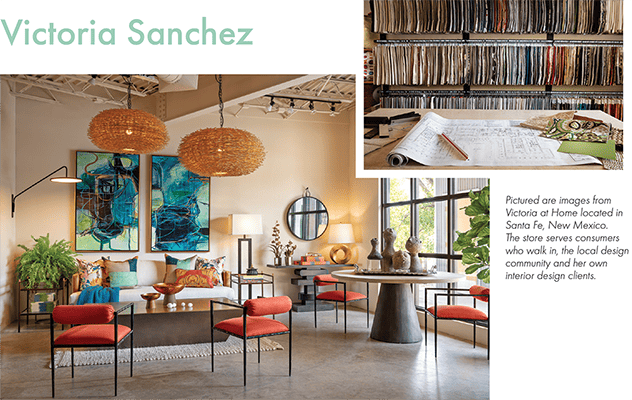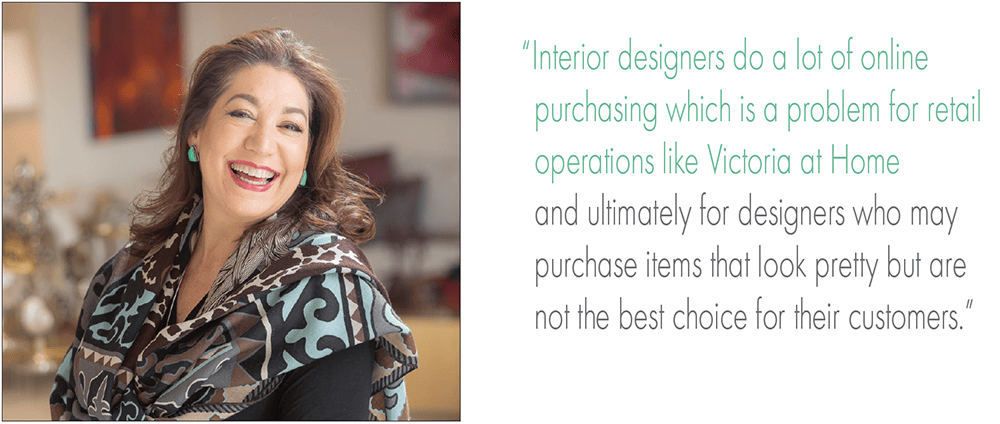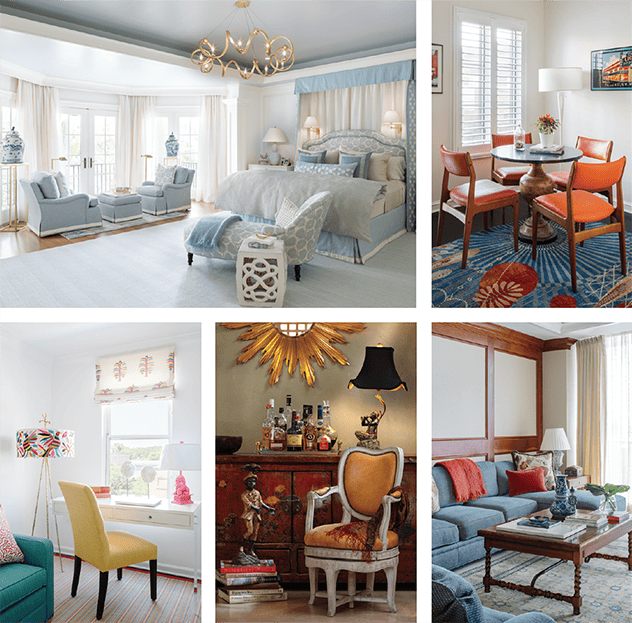
Interior designer, store owner and style spotter shares her thoughts on selling, supporting the interior design community, High Point Market and current trends.
Interior Designer Victoria Sanchez specializes in residential and commercial design, space planning and construction. Working from locations in Washington, DC, and Santa Fe, New Mexico, her Victoria at Home shop sells to consumers, her design clients and other interior designers. She has been a professor of interior design and a High Point Style Spotter. Furniture World asked Sanchez to share her ideas on current design trends as well as opportunities for collaboration between furniture retailers and the interior design community.
Early Years
“As a young girl growing up in Virginia, instead of dressing Barbies, I made houses and furnishings for them. My father bought a lot of residential real estate. We went to open houses together and I commented on every single one—’hate the carpet, love the draperies!’—that was the environment I grew up in.
“My goal was to go to study design in New York. But, it was 1980 and my mother decided that Marymount College would be a safer idea. I earned an undergraduate and a master’s degree in interior design from Marymount then taught interior design at the college level. I am a member of ASID and earned the Council for Interior Design Qualification (CIDQ).
“Early in my career, I worked for Hunter-Miller and Associates which at the time was one of the best known architectural interior firms in the country. Also at a high-end residential design firm that turned out to be great training.”

Design Philosophy
When asked about how she approaches her work, Sanchez explained, “My interior design installations are all very different because I believe in giving clients what they want. I do, however, insist on comfort, and don’t settle for low-end quality because I know that won’t make them happy. I stick to the seven principles of interior design—rhythm, scale & proportion, balance, emphasis, contrast, harmony and unity.
“So, even if a client insists on a color or an arm detail I wouldn’t want in my home, as long as the work includes those principles and makes sense, it will still be a successful project for them. My designs aren’t trendy, but they tend to be very colorful.
“1987 was the first time I visited High Point market. Last year I was a Style Spotter which was challenging because it was done virtually. The High Point Market Authority fed us lots of information and my strong relationships with vendors were useful. I was able to reach out to them for additional information. It was an interesting experience and also lots of fun. Thousands of designers and buyers look to Style Spotters to identify important new products, summarize trends and call out what’s new.”

Victoria at Home Retail Store
“My previous Victoria at Home location was on King Street in the historic section of Old Town Alexandria, Virginia. When we moved the operation to New Mexico I chose to locate in a business park with other like-minded showrooms including Hunter Douglas, a plumbing supply showroom, Pella Windows and others. Across the street is a gluten-free organic restaurant that is well known here in Santa Fe. Victoria at home is located directly across from the restaurant. Local designers already know where to find me, we get retail walk-ins from the restaurant and the showroom is used by my design clients as well.”
Secrets to Success
“Before doing this interview,” Sanchez explained, “I reviewed a recent Furniture World interview with Corey Damen Jenkins. He mentioned how irritating it is for a designer to visit a furniture store and be ignored. I’m a busy businessperson, so when I walk into a furniture store, I want to be greeted, and I want to be sold. That’s something I keep in mind as a store owner servicing both consumers and interior designers.
“One of the things that has made my stores very successful is that when an interior designer or a consumer walks in, they are greeted as if they are walking into my home. We welcome them, ask them to sit down if they are there for a
meeting and offer them something to drink. It’s a shame that a welcoming attitude is missing in many home furnishings stores, design centers and showrooms at furniture markets.”
One of the things that
has made my stores very
successful is that when
an interior designer or a consumer walks in,
they are greeted as if they are walking into my home. |
There To Sell
Sanchez says that the element of selling is an important component that’s missing in the education of interior designers. “In my days teaching interior design professional practices, I always emphasized how important it is to be, and to feel good about being, a salesperson that sells interior design.
“That’s because whether you are a salesperson in a retail store or a professional interior designer, if you aren’t fully comfortable selling your products and ideas, then you are in the wrong business. We make money when we sell a sofa, but a big part of our job is to sell the perfect sofa, the one that our customers will love when they watch TV or entertain.” That sofa, noted Sanchez, may come with a hefty price tag. “So, it’s not useful for people who make their living selling furniture,” she said, “to be afraid to let a client know it’s an $8,000 sofa just because that price tag might scare them [the salesperson] away. Never be afraid of price tags.”
An eCommerce Challenge
“Interior designers do a lot of online purchasing which is a problem for retail operations like Victoria at Home and ultimately for the designers who may purchase items that look pretty but are not the best choice for their customers.”
Sanchez says that it’s a mistake for designers to purchase items from the same online sources as their customers. “We need to differentiate ourselves to preserve the value we bring to our work. A better understanding of the products we specify can be gotten by going to furniture shows, frequenting design centers and developing relationships with home furnishings retailers including design-oriented operations like Victoria at Home.”
Getting Started in Retail
“Although I started my store as a portfolio for what I do and who I am as a designer,” she noted, “Victoria at Home has also been a way to support my fellow interior designers. Unlike New York, LA, Miami and Las Vegas, here in Santa Fe, we don’t have a large design centers that offer discounts to interior designers. One of the reasons I’m expanding my store is to fill this void. A lot of retailers give interior designers 10 percent off. I do 20 percent off on the floor. Designers who purchase from me can choose to pass on the 20 percent savings or they can make a little money themselves. If it’s just two pillows, they’ll probably pass on the discount. If it’s a $5,000 sofa, they might keep it. I also extend a portion of my trade discounts to designers on special orders.”
Retail Point of View
“Big brands like Anthropologie, Room & Board and Pottery Barn have developed their brand stories down to a science. But I think that many independent retailers either try too hard to have something for everyone or go too safe. They either don’t create compelling stories or fail to effectively communicate them to their customers. That’s a shame since it’s one of the best ways to engage and close sales. If a retailer is selling a piece of artwork that will be the perfect focal point for a customer’s living room or, if a hot pink accent chair presented to a shopper is the same color that was trending at the recent High Point Market, it can be the basis for a story to tell.”
End of Brick & Mortar?
“Some people have predicted the end of brick and mortar. I don’t agree. People still want to do research in person, to see the colors, scale, comfort and textures. Good in-person shopping experiences will never go out of style.
“Furniture retailers need to remember that their best potential repeat customers, especially for higher-margin goods, are designers. It’s obvious that many retailers don’t see it that way, but those who do should develop a program and post it online. If it’s simple and appealing, why wouldn’t designers in your trading area come to you first?”
A Retail Design Niche
Sanchez believes that there is an opportunity for members of the design community to follow her example at Victoria at Home to serve designers locally and fill a niche as a boutique retailer serving consumers of higher-end furnishings.
“People who walk into a decorating shop like Victoria at Home come in happy,” she observed. “They want to be there, and they expect to have an enjoyable experience surrounded by beautiful things. It’s a lot different than a lot of other retail experiences where people expect the opposite.
“My previous store in Virginia was small, only about 2,000 square feet. We initially set aside just $75,000 to purchase opening inventory. That may not seem like much, but when an interior designer decides to go into retail, $75,000 can feel like a big risk. As it turned out, I spent about twice that much to fill my shop. Designers I speak to at High Point are fascinated by the idea of getting into retail, but are fearful of diving in and making the investment. There is a need in our industry for a short course in operating a retail store—perhaps round-table discussions at High Point Market or a formal mentoring program. I don’t think there’s a lot out there to help designers approach retail as an add-on to their brand. Buying for a store is a lot different than looking for a pretty table for a one-off client. They need to take a deep dive into furniture quality, retail operations and finance.
“There is also a need to change the way we educate interior designers. So, instead of having one general curriculum that tries to be everything to everybody, we need to have three different curricula. One for residential, another for commercial, and a third to teach presentation skills and techniques. Design schools don’t typically teach topics such as business law, marketing and finance required to learn how to make money in the field.”
Trends
Moving on to her trend expertise, Furniture World asked Sanchez to provide insight into the trends she’s identified in her business and as a High Point Style Spotter.
Natural, Organic Materials. “The usefulness of trends for retailers” she explained, ”varies by region and target customer, but in general, natural materials, fibers and finishes are huge. This includes furniture, lighting, floor coverings and accessories incorporating rattan, linen fabrics and wicker. We saw lots of organic forms at the recent High Point market. Even if a product is made from resin instead of clay, if it has a natural look, people are attracted.”
Resurgence of Traditional. “Another more traditional trend that’s perhaps most appropriate for markets in the northern and eastern U.S. has emerged. We’re seeing more brown furniture—not quite old-fashioned sideboards and hutches—but traditional fabrics and colors, jewel tones, reds, greens, golds and purples. Some people, especially older consumers are finding comfort in traditional design. Younger consumers, on the other hand, are looking for more natural neutral tones, organic shapes and forms.
At High Point, I noticed
that a lot of manufacturers pulled away from nail heads and blah greys in favor of chintzes, patterns, tailored fashion details
and color excitement. |
“I don’t think these trends are entirely a reaction to people being homebound during the pandemic. They started to emerge about four years ago. Boho Chic has become a little bit passe. Neutral organic California sun hats and old VW vans have become more the look for the 20- and 30-somethings.”
Other Trends. “On one hand I’m seeing a trend toward more modern, sinuous, molded foam furniture. People love it because it’s fun, novel, and can be found at all price points. At the same time, we’re seeing more traditional details, comfort and style. At High Point, a lot of manufacturers pulled away from nail heads and blah greys in favor of chintzes, patterns, tailored fashion details and color excitement. During the pandemic, a lot of people focused on outdoor spaces. This surge will continue.”
Private Spaces. “When people were forced inside during COVID, a desire to have more private spaces emerged. The ability to achieve privacy is limited by available square footage and the part of the country people live in. Here in New Mexico, we have so much land, we tend to build out. A family that lives in a small house or a historic townhouse in the Georgetown area of Washington, DC, won’t have the luxury of having a workspace for each of their five children. I’m hearing from customers that there has been a shift in how they want to experience their living spaces. They aren’t as happy with big open spaces and double-story family rooms where everyone can hear everything. They don’t want to have multi-functional rooms where the whole family spends much of their time. Right now, they are looking to design spaces that allow for privacy and individual activities.”

Sanchez says she isn’t known for producing trendy designs or working within a particular style period. She gives her customers what they want but she always builds in comfort and product quality.
|
Furniture World is the oldest, continuously published trade publication in the United States. It is published for the benefit of furniture retail executives. Print circulation of 20,000 is directed primarily to furniture retailers in the US and Canada. In 1970, the magazine established and endowed the Bernice Bienenstock Furniture Library (www.furniturelibrary.com) in High Point, NC, now a public foundation containing more than 5,000 books on furniture and design dating from 1620. For more information contact editor@furninfo.com.